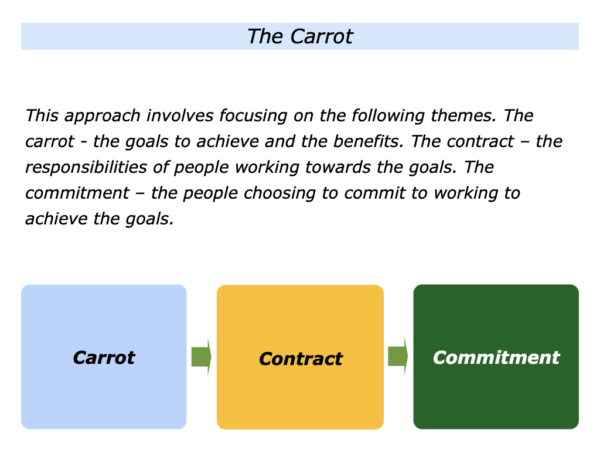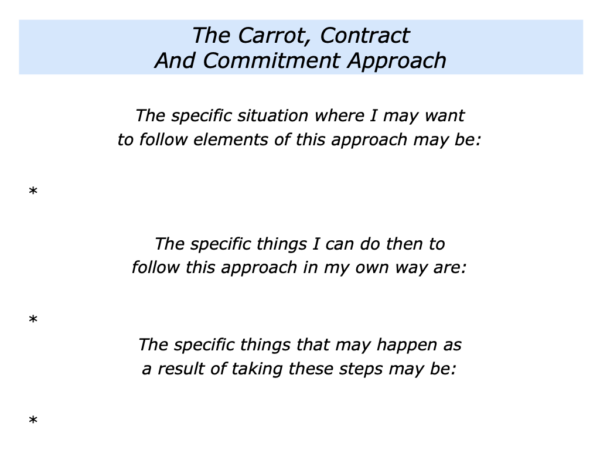
There are many ways to encourage people to achieve specific goals. This is an approach that I have seen used by therapists, educators, coaches, leaders and people in other roles. It sounds basic but, when used respectfully, it can be effective.
The approach involves describing the carrot and the working contract. It then involves inviting people to decide if they wish to commit to doing their best to achieve the goals. Let’s explore how this works in action.
The Carrot
The first step involves describing the carrot – such as the goals to achieve and the benefits. Different people describe this in different ways in different situations. Let’s consider some examples.
The Leader’s Approach
Some leaders describe a vision that people find inspiring. They may talk about having a dream, doing things that are insanely great or creating an ethical business that shows a better way.
Some leaders describe the team’s purpose, principles and picture of success. Bringing this to life with examples, they work through the following framework.
The Purpose
The purpose of our team – the
specific thing we want to do – is:
*
The positive benefits of
achieving this purpose will be:
*
*
*
The Principles
The principles we want to follow
when pursuing this purpose are:
*
*
*
The Picture Of Success
The picture of success – the specific
things we want to achieve by … – are:
*
*
*
Different leaders describe this in different ways. Whatever method they choose, the aim is to show people the big picture, the key strategies and the benefits of achieving the goals.
The Contract
The second step is to explain the contract. This involves describing the responsibilities of various people in working to achieve the goals. The leader may say something along the following lines.
The leadership team’s responsibilities in
working towards achieving the goals are:
*
*
*
The managers’ responsibilities in working
towards achieving the goals are:
*
*
*
The team members’ responsibilities in
working towards achieving the goals are:
*
*
*
The aim is to describe the attitudes and actions that people are encouraged to follow to work towards achieving the goals. It is also important to explain the reasons for following these principles to achieve success.
The Commitment
The third step is to invite people to decide if they want to commit to working towards achieving the goals. Different leaders do this in different ways.
Some leaders invite people to take time to reflect on whether they really want to take this step. They make sure that people know the pluses and minuses involved in doing the work. One leader expressed this in the following way.
“I want people to know the full picture – the pluses and minuses involved – before they commit.
“Providing I give them this information, is not my job to get them to get them to commit.
“It is their job to decide if they want to commit.”
Such leaders then meet with the individuals who want to work towards achieving the goals. Bearing in mind the person’s strengths, they make clear contracts about:
The specific contribution – the specific outcomes – the person will deliver towards achieving the goals;
The specific strategies they will follow and the specific support they need to achieve their contribution;
The specific things they will proactively do to keep people informed about their progress towards achieving the goals.
The leader then meets with people on a regular basis. Bearing in mind the outcomes the team member aims to deliver, they encourage them to perform superb work and do their best to achieve the picture of success.
This is an approach I have seen work in teams. It is one that can also be used in other situations. Let’s look at one example.
The Therapist’s Approach
Imagine that you are a therapist and a client asks for your help. You will start by making them feel welcome and clarifying their goals. Different individuals will want to achieve different things. They may aim:
To give up drugs … To take more control of their life … To manage their emotions … To feel more at peace … To achieve other goals.
Bearing in mind their aims, it can be important to help them:
To set a positive goal;
To see the benefits of achieving the goal – this is the carrot.
It can also be useful for the person to recognise both: a) the upsides; b) the downsides involved in working towards achieving a goal. They can then decide if they are prepared to do what is required to achieve the prize.
Bearing these factors in mind, it can be good to spend a lot of time helping a person to see the benefits of achieving the goal. Some people will only change their lifestyle, for example, if there is a big enough carrot.
Imagine that a person is prepared to accept the whole package involved in working to achieve the goal. You may then move on to making a clear working contract. This may involve you explaining the following things.
My responsibilities as a therapist in helping
you to work towards achieving your goal are:
*
*
*
Your responsibilities in working
towards achieving your goal are:
*
*
*
Clear contracting is important in many areas of life. This is especially so in professional relationships. Many therapists therefore make clear working contracts when helping a client.
Imagine you have go to this point. You can then move on to the next step – commitment. Sometimes this involves revisiting some of the earlier themes. One approach is to encourage the client:
To clarify the specific goal they want to achieve;
To clarify the pluses and minuses involved in working to achieve the goal;
To clarify their commitment to doing their best to achieve the goal.
Different therapists clarify a person’s commitment in different ways. One approach is to invite them to do the following exercise.
My Commitment
The extent to which I am motivated – on a scale
0-10 – to do what is required to achieve the goal is:
____ / 10
The person’s rating needs to be at least 7+/10. If appropriate, you can also encourage the person to focus on the specific things they can do to maintain or improve the rating.
Imagine that you have worked through these steps with a client. You can then help them to follow the strategies most likely to achieve their picture of success.
There are many ways to encourage people to work towards achieving a goal. One approach is to focus on the carrot, contract and commitment. This can be used when working with teams, individuals or even organisations.
Looking ahead, can you think of a situation where you may want to follow elements of this approach? How can you do this in your own way? What may happen as a result of taking these steps?
If you wish, try tackling the exercise on this theme. This invites you to complete the following sentences.







Leave a Reply